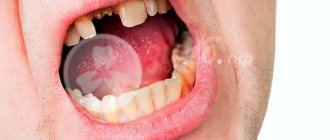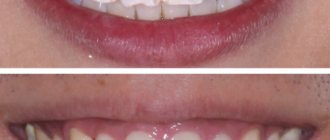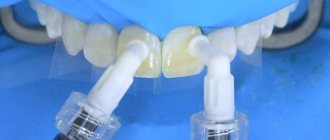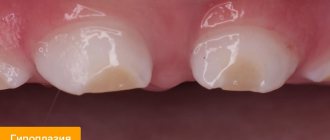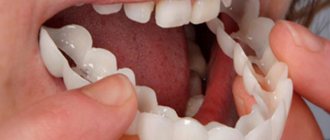Tooth enamel is a protective shell that covers each tooth individually to protect it from various types of damage. Despite the high strength of tooth enamel, it can be destroyed due to mechanical, temperature, bacterial and chemical damage. High-quality oral care will ensure healthy teeth for many years. This article will discuss effective ways to restore tooth enamel at home and using professional methods.
- Remineralization
Composition and structure of tooth enamel
Tooth enamel is one of the strongest substances in the human body and completely covers the crown of the teeth. Under the layers of enamel there is dentin and a pulp chamber with a neurovascular bundle. A mixture of increased hardness made from collagen and calcium fibers (also called dental cement) covers the entire surface of the root system.
Composition of tooth enamel:
- 96% minerals, mainly calcium phosphate in the form of hydroxyapatite crystals
- 2% organic matter
- remaining 2% water
Strength of tooth enamel:
- Surface layers are the most durable and provide protection
- Cervical area and sides - density decreases
The average density on the chewing surface is 1.5 - 1.6 mm.
Types of fluoridation
Currently, fluoridation of teeth is carried out using two methods - simple and deep:
- Simple fluoridation . To carry out the procedure, special “spoons” are used that look like mouth guards, which are filled with a fluoride-containing composition and placed on the jaw for 10-15 minutes. To complete the full course, you need to conduct at least 10 sessions. An alternative option is simple fluoridation using a fluoride-containing varnish. It is applied with a special brush to the surface of the teeth and allowed to dry. The full course consists of 3-4 procedures, depending on the individual characteristics of the body and the drug used.
- Deep fluoridation . The main difference between this method and the previous one is the use of special enamel-sealing preparations. In addition, deep fluoridation requires careful preparation of teeth, therefore it is carried out exclusively in professional clinics. After the stage of cleaning the teeth, a special composition is applied to their surface using a tampon for 1-2 minutes, after which it is dried under the pressure of warm air. Then the surface of the teeth is stained with a swab dipped in calcium copper hydroxide milk, and then rinsed with clean warm water. The advantage of deep fluoridation is that the solution penetrates into the deep layers of enamel, making teeth much stronger. According to dentists, the effectiveness of deep fluoridation is 5 times higher than that of simple fluoridation.
Causes of tooth enamel destruction
Despite its high strength, enamel tends to deteriorate, which jeopardizes the health of teeth and oral cavity. It is necessary to identify the cause of destruction in time and take action - then it will be possible to slow down the process and the process of restoring the enamel using simple means will be available.
Poor nutrition
The most common cause of not only the destruction of tooth enamel, but also the appearance of diseases of the gums and oral cavity in general.
Negatively affects tooth enamel:
- Sudden changes in the temperature of food consumed (for example, drinking coffee and eating frozen foods).
- Frequent consumption of frozen vegetables and processed foods can cause digestive problems, which will certainly affect the health of tooth enamel.
- Lack of vitamins (for example, due to a strict vegetarian diet)
- Frequent consumption of carbonated drinks and sweets slowly destroys the enamel.
- Too sour and spicy foods also negatively affect enamel.
These are the most common reasons that relate to poor diet. If it turns out that there is a lack of vitamins in the body, you need to immediately start taking vitamin complexes, and then restore tooth enamel.
Caries
Caries is the main cause of enamel destruction throughout a person’s life. At first, caries does not cause any inconvenience, but in fact, the process of destruction of enamel begins immediately after the appearance of caries. The sooner you address this issue, the easier it will be to restore the enamel.
As a rule, the initial stage of caries development is accompanied by a change in the color of the teeth and the appearance of specific stains.
The next stage destroys tooth enamel more significantly and restoration becomes more difficult. Increased tooth sensitivity to: lemon, apple, sweets and other aggressive foods. Noticeable pigmentation appears, the enamel is damaged by the action of cariogenic bacteria and turns dark brown. Painful sensations are either rare or absent (but the destruction of enamel increases).
Deep caries is the last stage of development, accompanied by pain from eating and brushing teeth. At this stage, enamel restoration becomes a very problematic process and most home methods will no longer help. It is necessary to treat caries and then restore the enamel using professional means and methods in a dental clinic.
Bad habits - smoking and alcohol abuse
Smoking very quickly destroys tooth enamel as two destructive factors act simultaneously - temperature and bacterial. It greatly contributes to the development of caries, which in turn accelerates the destruction of enamel and deterioration of dental health.
Alcohol is not as harmful as smoking, but if abused, calcium and magnesium are washed out of the body , which subsequently leads to the destruction of enamel due to a lack of these elements. The result of the effect of alcohol on teeth is a change in the composition of saliva to a more aggressive one (acid-base). Rapid demineralization of dentin and tooth crowns occurs. Insufficient production of salivary fluid reduces the strength of the enamel and further exposes it to abrasion.
Chronic diseases
Chronic diseases have an extremely negative impact on dental health , including surface enamel. The most common chronic diseases that lead to rapid destruction of tooth enamel:
- Hypertension - contributes to the development of caries and the regular appearance of plaque on the teeth. This happens due to a significant decrease in the performance of the salivary glands (little saliva is produced and it ceases to protect the oral cavity at the required level).
- Increased acidity in the stomach (Gastritis). The negative effect on enamel is expressed in a decrease in the body's absorption of phosphorus and calcium (which are necessary for the health of enamel and teeth in general).
- Diabetes mellitus also leads to a lack of essential enamel minerals.
- Metabolic disorders and improper functioning of the thyroid gland lead to rapid destruction from a lack of vitamins and minerals.
- Taking antibiotics affects the entire body , and teeth are no exception. A recovery period is necessary to strengthen the enamel and immunity.
Malocclusions
Incorrect bite causes gradual destruction of the enamel mechanically , namely in the process of abrasion of layers as a result of strong pressure. When teeth do not fit well together due to unevenness, part of the enamel can break off and bacteria can penetrate inside the tooth. It is necessary to immediately contact a dentist and prevent all further mechanical damage.
An incorrect bite cannot be left without correction, since the enamel will quickly wear off and dentures and implants will have to be used to restore teeth. Some people have developed the habit of clenching their teeth tightly and this greatly damages the enamel. It also negatively affects certain areas of tooth enamel.
Poor oral hygiene
When a person stops devoting time to oral hygiene and dental care, caries and other diseases appear. The longer this continues, the more irreversible the process of tooth decay becomes.
If you notice plaque on your teeth (in large quantities), you need to remove it as quickly as possible, for example, with professional teeth cleaning at a dental clinic.
There are also many means and tools for maintaining the health of tooth enamel at a high level. It is better to immediately get used to using professional toothpastes, gels and rinses, if possible. To prevent caries and periodontitis, use professional irrigators.
Composite dental restoration
Even the most ordinary filling should be beautiful. Therefore, direct composite dental restoration in dentistry is increasingly becoming an alternative to conventional filling and is actively used as the final stage in the treatment of caries. This technique should be carried out in specially equipped dental offices by specialists with certain qualifications, and using highly aesthetic light-curing composite materials. All this increases not only the quality of dental treatment, but also its cost (prices for dental restoration in Moscow can vary from 1,500 rubles to 50,000 rubles per tooth). But how can an ordinary patient understand how dental restoration with a composite material differs from a traditional filling, and is it worth overpaying for it?
The main difference between composite dental restoration and conventional filling is the final result. The restored tooth becomes identical in color to its natural counterpart. Its natural shape is restored taking into account all anatomical features. If the composite restoration of the anterior teeth is carried out efficiently, the patient will not be able to detect the presence of a filling by touch with his tongue and will not experience the sensation of something foreign in the oral cavity when closing the jaws. The latter aspect is of paramount importance for the normal function of the temporomandibular joint, which is important for the health of not only the oral cavity, but the entire body as a whole.
Photos before and after restoration of anterior teeth with composites
Professional methods for restoring tooth enamel
In most cases, damaged enamel requires professional restoration at a dental clinic. There are many methods, we will look at the most popular ones, as well as an innovative method of restoring teeth using the drug Innodent Repair .
Remineralization
Remineralization ensures restoration of the structure of tooth enamel by stabilizing the balance of minerals present in tooth enamel. Professional remineralization in a dental clinic is carried out using products and preparations containing fluoride and calcium.
Main indications for the procedure:
- Loss of natural shine on teeth
- Lack of surface mineralization
- Development of carious enamel damage affecting the internal tissues of the tooth
- Toothache when eating high or low temperature foods, as well as sweet and sour foods.
The remineralization procedure occurs by coating the enamel with a special preparation containing the necessary complex of minerals necessary to maintain the integrity of the teeth’s incisors.
As a rule, it includes: ionized fluorides, components that increase the protective properties of enamel, phosphorus, zinc and calcium.
Contraindications and indications
To the question “When should you resort to dental fluoridation?” there is no clear answer. Dentists suggest performing it for children and adults as a preventive measure for caries, but there are other indications for coating teeth with fluoride-containing compounds:
- Increased sensitivity. As a rule, it manifests itself in the form of discomfort when eating cold foods or drinks, fresh fruits or vegetables. Fluoridation helps strengthen the enamel, thereby reducing dentin sensitivity.
- Tendency to develop caries. If you often visit dentists for dental treatment, then fluoridation is an excellent way to extend the life of your fillings and also prevent the formation of new enamel damage.
- Recent gum disease.
- Accumulation of a large amount of yellow plaque at the base of the tooth (above the gum).
- The fluoridation procedure is also carried out after removing braces.
- For children 6 years of age and older, fluoridation is recommended to prevent tooth decay and to maintain overall dental health.
Contraindications include only individual intolerance to certain elements of fluorine-containing formulations, as well as an excess of fluoride in the body. If the patient lives in an area where the fluoride content in the water is quite high, in this case the doctor will most likely offer you other preventative procedures to protect and strengthen the enamel.
Enamel implantation with Innodent
The procedure is new, but has already proven itself as an effective method for restoring tooth enamel .
- Painlessly cures caries in 1 month
- Relieves tooth sensitivity
- Removes white spots after braces
- Strengthens and mineralizes enamel
Description of the procedure:
Innodent is applied to the tooth surface, which in turn is integrated into the enamel structure at the molecular level. This is achieved through active substances whose characteristics coincide with dental tissues.
Main results:
Cracks and damage to the enamel are completely eliminated, the integrity of the tooth enamel is restored and the process of regeneration of the natural structure begins.
When will the results of the procedure be visible?
You will see the first results 3 days after the start of the procedure, but the process of tooth enamel regeneration itself can last 1-1.5 months. A decrease in the sensitivity of enamel to mechanical and temperature stimuli also occurs gradually. In individual cases, it is possible to re-use the drug after 3-4 months.
Indications for the dental enamel implantation procedure
Below we will describe the main indications for which enamel implantation will be the most effective restoration method.
- High sensitivity of teeth (temperature and mechanical)
- Damage (chips) and cracks in tooth enamel
- Wedge-shaped defect (hyperplasia)
- Tendency of teeth to the spread of caries
- Pigment spots on the surface of tooth enamel
- At the initial stage of caries spread
An important feature of the drug is the possibility of use for preventive purposes, as well as in conjunction with teeth whitening procedures. Effectively copes with the treatment of enamel demineralization. It is possible to carry out the procedure after correction with braces in order to eliminate age spots on the surface of the enamel.
Are there any contraindications to the procedure?
The procedure is completely safe and has no contraindications as such. However, in rare cases, the following are possible: an allergic reaction and individual intolerance to one or more components of Innodent. You should not carry out the procedure with major damage to the internal tissues of the tooth.
Pros and cons of dental enamel implantation with Innodent
Main advantages:
- High degree of safety and natural ingredients
- Suitable for pregnant women and children (including baby teeth)
- As a result, you get smooth enamel with a natural shade
- Stains and damage are completely eliminated within a month
- Can be used at the initial stage of caries development and thereby avoid drilling and filling teeth
- Complete painlessness and absence of discomfort for the patient at all stages of the procedure
- The procedure is quick - about 15-25 minutes for everything
- The result lasts really long (from 1 to 3 years)
Flaws:
- Price - the method is not the cheapest, but in terms of price-quality ratio it has no analogues
- Really good results are possible a month after the procedure
- Does not solve the problem with large defects (internal tooth decay)
Dental implantation with the help of Innodent has allowed modern dentistry to truly restore enamel, and not replace it with temporary solutions.
A completely new approach to enamel restoration
Dental treatments
If teeth have decayed down to dentin, no therapeutic restoration methods will help. Hard tissues are not renewed, so the integrity of the tooth can be restored using radical methods. Modern dentists use polymer materials to replace a damaged crown, while maintaining its aesthetic qualities.
The use of reflective materials for fillings allows the doctor to simulate a dental crown of any shape. The filling hardens under the influence of ultraviolet rays.
Restoration with filling is carried out not only when caries is detected, but also when the enamel is erased, when hard tissues are chipped or crushed. This restoration method is most often used for front teeth. The aesthetic side of restoration with this method is at a high level. Even with a thorough inspection, it is not always possible to determine where the restoration was carried out. Only after several years have passed can you see a thin strip on the border between the tooth and the artificial material.
Another modern restoration method is prosthetics and veneers. This method is used when it is not possible to install a filling - the defect covers more than 70% of hard tissues. Modern technologies make it possible to create a virtual model of the crown and grind it using diamond milling machines. This type of recovery is highly reliable and fast. Installation of veneers and lumineers is carried out if the patient’s hard tooth tissues are destroyed. The cost of restoring tooth enamel depends on the complexity of the work and the price of materials.
Innodent Repair™
Manufacturer:
Bachem AG, Switzerland, according to GMP standards
Package:
1 bottle
Storage:
Store InnoDent™ Repair in the freezer (-15°C or below).
Transportation:
Delivery within the city without refrigerant in cold weather is allowed. During the warm season and when transporting long distances - delivery in polystyrene foam with refrigerant.
Innodent in dental practice.pdf Treatment of caries in children with InnoDent.pdf Swiss raw materials for the treatment of caries without pain
Submit your application
Stages of the procedure
Regardless of the chosen fluoridation method, this procedure includes the following steps:
- Oral hygiene. This can be either a full professional cleaning (removal of plaque and tartar), or a simple treatment with antiseptic dental compounds. The tooth surface must be clean before applying fluoride-containing compounds so that the mineral substances can protect the enamel.
- Thorough drying with warm air.
- Depending on the chosen method of fluoridation, either fluoride-containing varnish is applied to the teeth, or a mouth guard with a special paste is put on for 10-15 minutes.
- During deep fluoridation, the surface of the teeth is covered with an enamel-sealing liquid, which is thoroughly dried and carefully shaded. After 1-2 minutes, rinse the oral cavity.
It is also important to understand that fluoridation is advisable only on healthy teeth, so before the procedure it is imperative to sanitize the oral cavity.
Prof. hygiene with 20% discount
Moscow
Deep fluoridation of tooth enamel
Deep fluoridation involves saturating tooth enamel with various minerals that prevent the development of caries. Fluoride-containing substances prevent the destruction of tooth enamel.
Main indications for the procedure:
- To prevent caries
- After installing the filling (to increase its service life)
- High sensitivity of teeth
- General strengthening of tooth enamel
- The need for bleaching and stain removal
- Caries in the active stage
Contraindications:
- Individual intolerance to fluoride-containing components
- Epidemic fluorosis
The procedure is completely safe and painless, but fluoride oversaturation is possible. To avoid this, stop using fluoride-containing medications, including toothpastes, before the procedure.
Main stages of deep fluoridation:
- Complete cleaning of teeth from tartar and plaque (professional cleaning of the oral cavity)
- Using special preparations, the oral cavity is dried with a warm air stream.
- A special sealing agent is applied and dried after a few minutes.
- Teeth shading is carried out - surface treatment of tooth enamel with a solution of copper and calcium hydroxide
Deep fluoridation of tooth enamel is an effective procedure, but its quality is inferior to enamel implantation with Innodent.
Prevention of destruction
Restoring the color of tooth enamel is a rather complex and labor-intensive process, so it is easier to carry out preventive measures. Follow the following recommendations, and you will enjoy healthy and beautiful teeth for a long time:
- After each meal, perform oral hygiene; if this is not possible, just rinse it;
- add to your diet foods high in vitamins and minerals (eggs, cottage cheese, fish, vegetables and fruits);
- reduce the amount of foods high in sugar;
- choose a brush with medium-hard bristles;
- massage your gums once a day;
- refuse toothpaste with whitening effect;
- do not abuse chewing gum;
- Get regular dental check-ups to catch the problem early.
Do not forget that it is very difficult to restore damaged teeth on your own, so we recommend that you contact a specialized clinic. Modern diagnostic equipment allows you to identify even minor injuries, and professional doctors will offer effective treatment methods.
